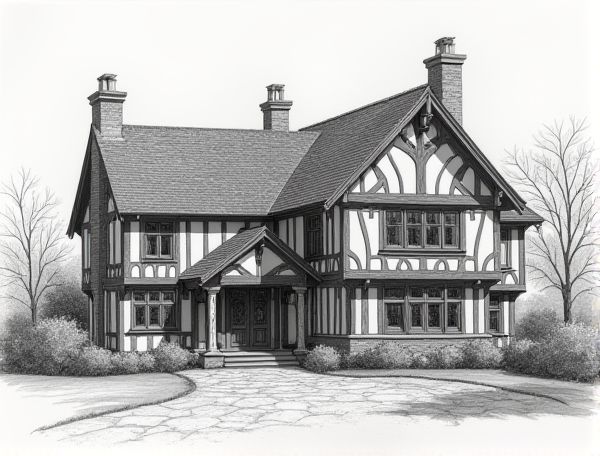
Photo illustration: Tudor revival home design with half-timbered façade restoration
Tudor revival home design showcases a distinctive half-timbered facade that requires meticulous restoration to preserve its historic charm and architectural integrity. Enhance your home's timeless beauty and learn expert techniques for restoring these classic details by reading the full article.
Introduction to Tudor Revival Home Design
Tudor Revival home design emphasizes steeply pitched gable roofs, decorative half-timbering, and tall, narrow windows with small panes, creating a charming blend of medieval English aesthetics and modern comfort. Your home's exterior showcases textured brickwork or stucco alongside massive chimneys to capture the characteristic old-world charm. This design style harmonizes historical elements with contemporary functionality to offer a timeless yet practical living space.
Historical Origins of the Half-Timbered Façade
The half-timbered facade traces its origins back to medieval Europe, particularly popular in regions like Tudor England and Alsace, France. This architectural style features timber frames with spaces filled by plaster, brick, or wattle and daub, showcasing both functional and decorative elements. Understanding these historical roots allows you to incorporate authentic design aesthetics into your home, blending tradition with modern living.
Key Architectural Features of Tudor Revival Homes
Tudor Revival homes showcase steeply pitched gable roofs, decorative half-timbering, and tall, narrow windows often with leaded glass, reflecting medieval English architecture. Prominent masonry chimneys, arched doorways, and asymmetrical facades further enhance the historic charm and distinctive character of these residences.
Assessing the Condition of Original Half-Timbering
Careful inspection of original half-timbering reveals critical signs of wood rot, insect damage, and structural shifts, which are essential for preserving historic integrity. Using moisture meters, borescopes, and structural analysis ensures accurate assessment and informs effective restoration strategies.
Selecting Authentic Materials for Restoration
Selecting authentic materials for restoration enhances your home's historical integrity and ensures long-lasting durability by matching original textures, colors, and craftsmanship. Using period-specific wood, stone, or metal not only preserves architectural authenticity but also contributes to sustainable, eco-friendly renovation practices.
Techniques for Repairing and Replacing Timbers
Timber repair techniques such as epoxy consolidation and splicing effectively restore structural integrity by filling cracks and reinforcing weak sections. Replacing damaged timbers involves precise measurement and custom cutting to fit seamlessly within your home's framework, ensuring stability and aesthetic consistency. Using treated or engineered wood enhances durability and resistance to future decay, safeguarding your investment.
Preserving Historic Masonry and Stucco Details
Preserving historic masonry and stucco details requires meticulous attention to original materials and craftsmanship techniques to maintain structural integrity and authentic aesthetics. You should employ gentle cleaning methods, compatible mortar mixes, and appropriate sealants designed for historic surfaces to prevent damage and ensure long-lasting preservation. Expert consultation is essential for restoring intricate patterns and textures, preserving the unique character of your home's architectural heritage.
Modern Solutions for Structural Integrity
Modern solutions for structural integrity incorporate advanced materials like carbon fiber-reinforced polymers and high-strength concrete, enhancing durability and resilience against environmental stresses. You can ensure your home withstands natural disasters and long-term wear by integrating smart load-bearing systems and seismic-resistant frameworks.
Enhancing Curb Appeal While Maintaining Authenticity
Enhancing curb appeal while maintaining authenticity involves selecting materials and design elements that reflect the original architectural style of your home, such as matching historic brickwork or period-appropriate colors. You can also incorporate native plants and traditional landscaping techniques to create a welcoming, cohesive exterior that honors your home's unique character.
Maintenance Tips for Restored Tudor Revival Exteriors
Preserving the character of your restored Tudor Revival exterior requires regular inspection of half-timbering and stucco to prevent moisture damage and wood rot. Applying breathable sealants and ensuring proper drainage around your home helps maintain the integrity of original materials. You should also schedule routine professional assessments to address any structural concerns early and keep your Tudor Revival design looking authentic.
 homedesy.com
homedesy.com